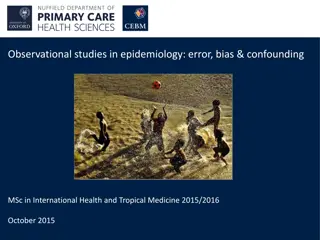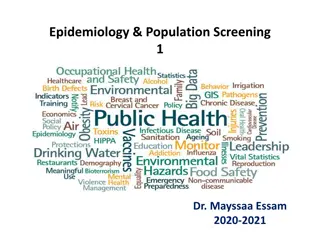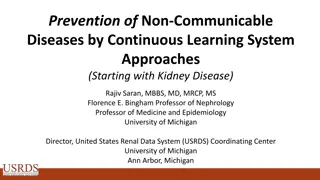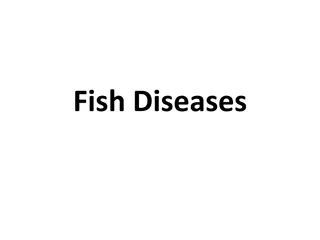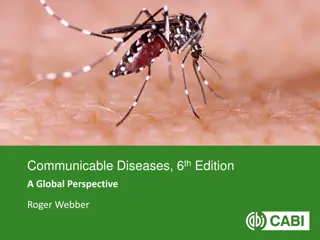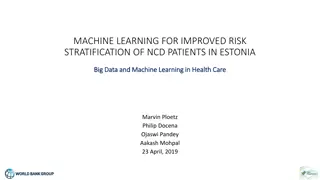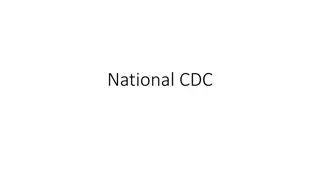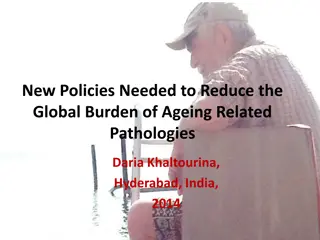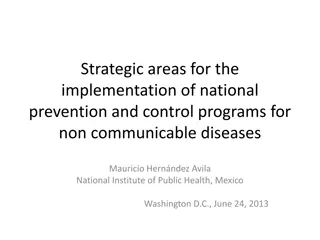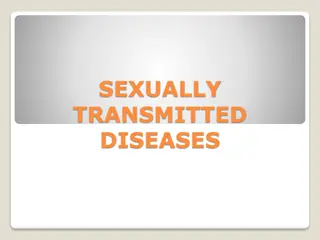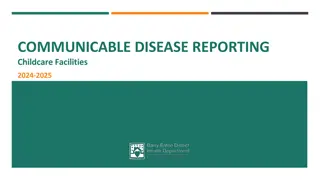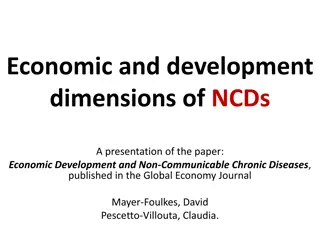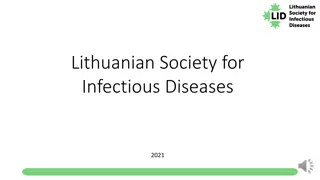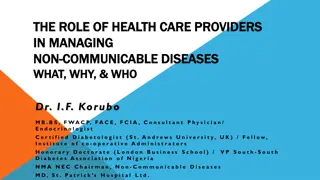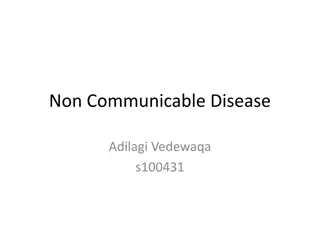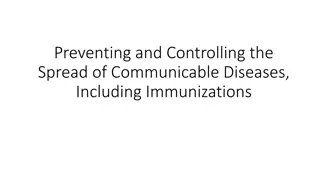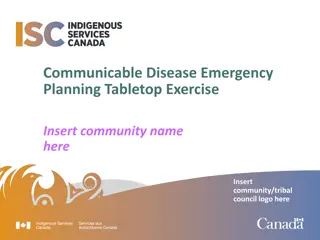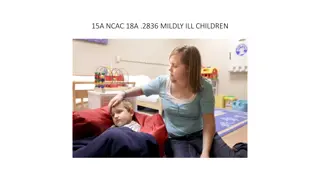Advocating for Multi-Sectorial Approach to NCD Prevention and Control in Zimbabwe
Zimbabwe faces a triple burden of diseases with a significant impact of non-communicable diseases (NCDs). The current policy approach on NCDs needs to change due to the increasing healthcare demands, rise in health expenditure, and implications on national budget and social protection. Key recommend
1 views • 10 slides
Understanding Non-Communicable Diseases and Prevention Strategies
Medical officer Dr. Richard Ayebare discusses non-communicable diseases (NCDs), highlighting their impact, common types in Uganda, cardiovascular risks, and modifiable vs. non-modifiable risk factors. Learn about the definition, worldwide picture, complications, and prevention methods of NCDs for a
0 views • 17 slides
Overview of Poultry Diseases and their Causes
Poultry diseases caused by viruses and bacteria are a significant concern for poultry farmers. Viral diseases like Ranikhet Disease, Fowl Pox, and Avian Leucosis can have high mortality rates and severe symptoms. Bacterial diseases such as Tick Fever, Tuberculosis, Fowl Cholera, and Infectious Coryz
2 views • 12 slides
Best Neurosurgery Hospitals in India
Neuro diseases are very bad diseases. Many people are caught by Neuro diseases nowadays. It is related to brain diseases. Many people in India are caught by Neuro Diseases. It happens in Adults as well as children.\nA person of any age can be affected by this. Before this time very bad disease Named
1 views • 2 slides
Point-of-care Diagnostics Market to be Worth $43.1 Billion by 2030
Emerging economies are fueling the demand for healthcare services and treatments due to rapid urbanization, improving healthcare infrastructures, increasing healthcare expenditures, growing healthcare insurance coverage, rising disposable incomes, and the growing prevalence of non-communicable and i
0 views • 3 slides
Understanding Observational Studies in Epidemiology
Delve into the realm of observational studies in epidemiology, exploring concepts such as error, bias, and confounding. Discover the significance of various study designs, from case reports to prospective cohort studies, in elucidating associations and establishing causality in non-communicable dise
0 views • 58 slides
Understanding Epidemiology: Disease Distribution and Population Health
Epidemiology is the study of disease distribution in populations, analyzing patterns, determinants, and risk factors to understand and control various health conditions. It encompasses infectious diseases like cholera, nutritional disorders such as scurvy, cancers like childhood leukemia, and non-co
1 views • 16 slides
Understanding Fungal and Protist Diseases: Impacts and Prevention
Fungi and protists play significant roles as pathogens, causing diseases in both humans and plants. Fungal diseases like athletes foot and protist diseases like malaria can have serious impacts on health. Control measures such as understanding symptoms, spread mechanisms, and prevention strategies a
0 views • 10 slides
Continuous Learning Approach for Preventing Kidney Disease and Non-Communicable Diseases
Addressing the global health crisis of Non-Communicable Diseases (NCDs), particularly Kidney Disease, through comprehensive prevention strategies. Emphasizing the need for upstream primary prevention, utilizing surveillance systems, prediction analytics, and tailored messaging to drive awareness and
0 views • 13 slides
Enhancing Health Care Delivery through Ayushman Bharat Health and Wellness Centers
Ayushman Bharat Health and Wellness Centers aim to provide comprehensive primary health care services, including oral, mental, and geriatric care. These centers integrate service delivery to cover communicable and non-communicable diseases, focusing on preventive, curative, and rehabilitative care.
0 views • 39 slides
Review of National Health Policy by Prof. A. Marthanda Pillai
Prof. A. Marthanda Pillai critically reviews the draft new national health policy, highlighting the need for clear objectives and increased health expenditure to address the rising burden of non-communicable diseases. The policy lacks direction in key areas like preventive care, health expenditure t
0 views • 25 slides
Promoting Physical Activity in Island Communities: The Urgent Need for Change
Island communities are facing a crisis of physical inactivity among children, leading to increasing rates of obesity and related health issues. Lack of promotion of physical activity in schools and workplaces is contributing to this problem. Urgent action is required to prioritize daily exercise and
0 views • 21 slides
Healthy Longevity Dashboard for Sierra Leone
Sierra Leone faces challenges in life expectancy and healthcare access, with high rates of child and maternal mortality. The Healthy Longevity dashboard aims to monitor and guide investments in non-communicable diseases (NCDs) and health longevity by tracking indicators across various domains in the
0 views • 15 slides
Promoting Physical Activity in the Workplace: A Path to Healthier and More Productive Workforce
The workplace plays a crucial role in encouraging physical activity to combat sedentary lifestyles prevalent in island communities. Access to daily exercise is vital to prevent non-communicable diseases linked to inactivity. Engaging in group activities and implementing interventions like flexible s
0 views • 16 slides
Understanding Fish Diseases and Health
Fish diseases and health are essential aspects of aquatic life. Diseases can be infectious or non-infectious, causing impairments to the normal state of fishes. Recognizing symptoms and signs of diseases is crucial for diagnosis and treatment. Overall, maintaining the health of fishes is vital for t
0 views • 21 slides
Understanding Communicable Diseases: A Global Perspective
Explore the dynamics of communicable diseases in the 6th edition of "Complimentary Teaching Materials - A Global Perspective" by Roger Webber. Learn about epidemic vs. endemic diseases, incubation periods, population dynamics, herd immunity, mathematical models for disease control, and various types
0 views • 13 slides
Global Health Challenges and Opportunities in the 21st Century
Unpacking the Sustainable Development Goals (SDGs), this content touches on important thresholds in global health, the impact of redefined priorities, the progress made since the MDGs, the rising burden of non-communicable diseases, lessons learned from the Ebola crisis, and challenges posed by urba
0 views • 14 slides
Machine Learning for Improved Risk Stratification in Health Care
Explore the use of machine learning for risk stratification of patients with non-communicable diseases in Estonia. This study showcases the application of big data and machine learning in healthcare, emphasizing the benefits of personalized care, proactive disease prevention, and efficient intervent
1 views • 77 slides
Zoonotic Diseases in Mongolia: A One Health Perspective
High risk of zoonosis in Mongolia is evident due to various factors such as livestock practices, wildlife diseases, and environmental changes. The National Center for Zoonotic Diseases in Mongolia plays a crucial role in studying, preventing, and raising awareness about over 160 zoonotic infectious
0 views • 13 slides
National Centre for Disease Control and Prevention (NCDC) in Saudi Arabia
The National Centre for Disease Control and Prevention (NCDC) in Saudi Arabia was established to address public health challenges through a multifactorial approach. By preventing and controlling communicable and non-communicable diseases, monitoring population health, and fostering public health sol
0 views • 8 slides
Addressing the Global Burden of Ageing-Related Pathologies: Strategies and Challenges
The presentation highlights the need for new policies to combat ageing-related pathologies, emphasizing the rising share of deaths due to non-communicable diseases globally. It covers the societal, professional, and biological aspects of ageing, along with legal considerations and initiatives for ag
2 views • 22 slides
Infection Control and Hand Hygiene Guidelines in Healthcare Settings
Learn about Standard Precautions focusing on hand hygiene to prevent the spread of communicable diseases like Norovirus, MRSA, Influenza, E. coli, and C. difficile. Understand the importance of proper hand hygiene practices in healthcare facilities, such as washing hands with soap and water, using h
0 views • 8 slides
Implementing Strategic Areas for Non-Communicable Disease Prevention
Implementation of national prevention and control programs for non-communicable diseases is crucial for sustainable healthcare systems. Collaborating with multidisciplinary groups and shifting advocacy paradigms towards human rights and social determinants of health are essential. A transformation i
1 views • 20 slides
Overview of Sexually Transmitted Diseases (STDs): Causes and Laboratory Diagnosis
Sexually transmitted diseases (STDs) encompass a variety of communicable infections transmitted mainly through sexual contact, caused by a diverse range of bacterial, viral, protozoal, and fungal agents. STDs can manifest as genital ulcers, discharge, or systemic symptoms. This article highlights di
0 views • 18 slides
Managing Communicable Disease Reporting in Childcare Facilities
Michigan law requires schools and childcare centers to report specific diseases promptly to the local health department. Reporting helps identify disease trends, outbreaks, and epidemics, enables preventative measures, aids in resource allocation, and supports disease surveillance efforts. Guideline
0 views • 18 slides
Common Regulated Diseases in Imported Fruit and Vegetables
Imported fruit and vegetables can carry regulated diseases such as Citrus Black Spot, Citrus Scab, and Citrus Canker. These diseases affect citrus fruits and peppers, causing scabs, spots, and cankers, making the produce unmarketable. The pathogens causing these diseases have been intercepted in imp
0 views • 12 slides
Economic Development and Non-Communicable Diseases: Analyzing the Impact
This paper explores the economic dimensions of Non-Communicable Diseases (NCDs) such as alcohol, tobacco, junk food, and lack of exercise, which are largely preventable factors affecting economic development. Key concepts like unwholesome goods, demand and supply irrationality, and market power are
0 views • 22 slides
Understanding Prion Diseases: A Comprehensive Overview
Prion diseases, such as Transmissible Spongiform Encephalopathies (TSEs), are rare and fatal neurological disorders affecting both humans and animals. These diseases are characterized by long incubation periods, neuronal loss, and the absence of an inflammatory response. Caused by abnormal folding o
0 views • 12 slides
Lithuanian Society for Infectious Diseases: Advancing Infectious Diseases Diagnostics, Treatment, and Prevention
Lithuanian Society for Infectious Diseases is a non-profit organization in Lithuania that brings together healthcare professionals to improve the diagnosis, treatment, and prevention of infectious diseases. They participate in various initiatives, events, and collaborations, organize conferences, an
0 views • 7 slides
Wisconsin Public Health Statutes Overview
Explore Wisconsin's public health history, statutes, and administrative rules, including the formation of the State Board of Health, consolidation of public health statutes in 1993, and the statutory duties of local boards of health. Learn about the chapters covering administration, communicable dis
0 views • 16 slides
Advocacy Opportunities for SRH/FP in the Context of the SDGs
Exploring the advocacy opportunities for Sexual and Reproductive Health/Family Planning within the framework of the Sustainable Development Goals (SDGs) in the 2030 Agenda. The content discusses the integration of SRH/FP into Goal 3 of the SDGs, focusing on ensuring healthy lives and promoting well-
1 views • 13 slides
Changes in Nutrition and Agricultural Landscape
The agriculture and nutrition landscape has been rapidly transforming in recent years, with a shift towards greater attention to food quality and nutritional health influences. This transition is marked by changes in food systems, urbanization, technological advancements, and shifting demographics.
0 views • 41 slides
Managing Non-Communicable Diseases: Role of Health Care Providers
Non-communicable diseases (NCDs) like cardiovascular diseases, cancers, chronic respiratory diseases, and diabetes mellitus pose significant health challenges globally. This overview delves into the definition, epidemiology, and management strategies of NCDs, emphasizing the critical role of health
0 views • 18 slides
Understanding Non-Communicable Diseases and Global Action Plans
Non-communicable diseases (NCDs), such as cardiovascular diseases, cancers, chronic respiratory diseases, and diabetes, pose a major health threat globally, with 38 million deaths yearly. The Global Action Plan aims to reduce premature mortality from NCDs by 2025 through specific targets, including
0 views • 16 slides
Lesson Outlines and Vocabulary for Chapter 17 Hollenbeck Middle School 8th Grade
Explore Chapter 17 lesson outlines, bell ringers, vocabulary, and review exercises for 8th-grade students at Hollenbeck Middle School. Topics cover communicable diseases, immune system defense, pathogens, sexually transmitted infections, and the effects of diseases like AIDS on the immune system.
0 views • 7 slides
Understanding and Preventing Communicable Diseases
Communicable diseases, also known as contagious or infectious diseases, are caused by germs such as viruses, bacteria, fungi, and parasites. These illnesses spread from person to person through various means like body fluids and can have different treatment approaches. It is essential to know how th
0 views • 34 slides
Understanding Bloodborne, Airborne, and Droplet Pathogens in Workplace Training
Explore the importance of annual training for employees in contact with blood or blood products, as mandated by OSHA. Learn about occupational exposure, exposure control plans, disease processes, and types of diseases caused by microorganisms. Gain insights into normal flora, infectious diseases, an
0 views • 76 slides
Community Emergency Planning Tabletop Exercise
This tabletop exercise focuses on preparing communities for communicable disease emergencies by understanding the nature of communicable diseases, emergencies, and tabletop exercises. Participants will discuss how communicable diseases spread, the characteristics of a communicable disease emergency,
0 views • 11 slides
Guidelines for Care of Mildly Ill Children in Child Care Centers
The guidelines outline the conditions under which child care centers can provide care for mildly ill children, specifying temperature limits, symptoms to watch for, and diseases that require separation. It also details procedures to prevent the spread of communicable diseases and requirements for ca
0 views • 7 slides
China's Health Transitions: Diseases of Poverty and Affluence
China's health transitions encompass changes in medicine and population health, influenced by factors like demographic shifts, disease patterns, and societal determinants. Challenges with data accuracy and the country's 20th-century demographic evolution are highlighted, including issues related to
0 views • 15 slides





